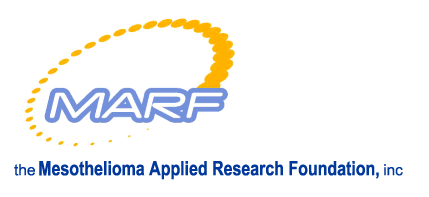
Our Mission is to eradicate mesothelioma as a life-ending disease.
Recommendation for a National Mesothelioma Research and Treatment Program
- A Key Part of the U.S. Asbestos Crisis' Solution
All sides acknowledge that asbestos is at least a $100 billion economic
problem in the U.S. The toll in human suffering and death is even worse.
The federal government must take some responsibility to address this tragedy.
Congress is obligated to "provide for the common welfare." And
it is uncontroversial that a high percentage of asbestos cancer victims
were exposed in U.S. Navy ships and shipyards, and that the government
should have done more to regulate asbestos after its dangers were evident.
Therefore, to lessen the suffering caused by the most lethal asbestos disease,
mesothelioma, The Mesothelioma Applied Research Foundation recommends
establishment of a National Mesothelioma Research and Treatment Program,
federally funded at $28 million per year. Through rigorous peer review
by an expert Medical Advisory Board, the NMRTP would select, and then
function primarily through, ten mesothelioma Centers of MERIT located
strategically throughout the country.
The first priority of the NMRTP and the Centers of MERIT would be to move
forward on exciting advances being made in early detection and prevention.
Whether so called "unimpaired" asbestos patients should be legally
compensated is being debated, but certainly these and the millions of
other high-risk individuals must be provided medically with hope that
(1) research is underway to provide for early detection of mesothelioma
and possible preventive measures and (2) should they ever become afflicted
with the cancer, a meaningful program will be in place that offers reasonable
and accessible treatment options.
The second priority is research to improve treatments for, and ultimately
cure, mesothelioma. This includes all of the novel surgical, chemotherapeutic,
radiation-associated, and biologic strategies now being pursued. It includes
pain management, a crucial issue for mesothelioma patients. It also includes
a registry and tissue bank. Unlike most European nations, the U.S. does
not maintain a comprehensive registry for mesothelioma as a reportable disease.
The final priority is education. Along with these new initiatives, public
awareness must increase. Young investigators and clinicians must be steered
toward mesothelioma and trained. An annual Mesothelioma Symposium to highlight
the newest benchwork and clinical advances in the disease must be supported.
And to provide a "one stop shop" for mesothelioma patients,
family members and front-line physicians to get comprehensive, current
information on all relevant aspects of mesothelioma, an Internet-based
Mesothelioma Educational Resource Center must be developed.
Investment in these key areas now is essential to save lives and reduce
the suffering - human and economic - in the long run.